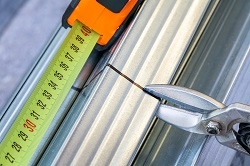
The path to construction perfection is paved by using the right materials and right tools for the right job. While wood studs are still the favored framing option, steel studs have some clear benefits when you’re comparing apples to apples. Here are five problems with wood studs and how steel ones address them.
- Wood studs are heavy and bulky. Pile up 20 8’ wood studs and you’ve got several trips of heavy, awkward loads in your future. Look to the steel counterpart and you can do it one trip. Steel studs are hollowed out so they can nestle into the next one. They save space and the back breaking, wall denting work of carrying them through a site.
- Wood studs warp, rot, and mildew. Wood is a natural material, and as such, it’s susceptible to water and insect damage. Moisture in the wood can cause it to swell, change shape, and grow mold. Any of these conditions can impact the structure of the stud as well, thereby weakening whatever you built with it. Steel studs aren’t at risk for any of those issues. They arrive perfectly straight and stay that way. The one risk of moisture is rust, but this can be mitigated with a vapor barrier.
- Wood studs vary. Because they are produced from nature, there are natural differences in each stud. This can cause slight angles, knots and twists, all which can add complexity to your construction. Steel studs come straight and each can be installed with tremendous precision.
- Wood studs lead to saw dust. Cutting wood studs inevitably leads to saw dust, and that stuff gets everywhere. Steel studs can be cut with aviation snips. No dust!
- Wood studs are unforgiving. Steel studs are used in situations where there is expected to be some movement to the structure, like high-rises and buildings in earthquake prone areas. They maintain their strength while allowing for some flexibility. They can also be moved without damage, just by backing out the screws and adjusting the placement. Wood studs will wear down quicker in the movement scenario and every time you make an adjustment, you’ll likely need a new hole, adding a new point of weakness.
If you’re thinking steel studs might be the right fit for your next project, be sure to use the right tools for the job. BECK Group introduced the SCRAIL® STEELTHREAD® to pair perfectly with steel studs. The SCRAIL® STEELTHREAD® can be used for steel support joists, light-gauge steel construction, drywall-to-steel construction, and deck installation. The three longitudinal grooves ensure controlled displacement of the steel stud material. The SCRAIL® STEELTHREAD® also has all the benefits of the traditional SCRAIL®, like the ability to remove and adjust your fasteners at any point during your project plus superior hold and strength. Using any SCRAIL® product also ensures that the project will be twice as fast and completed correct the first time around.
.svg.png)

